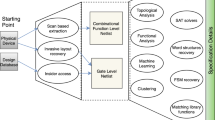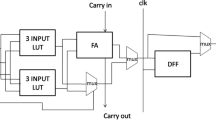Abstract
This paper presents a new level of description between behavioral and state descriptions of a finite-state machine (FSM). The description is termed behavioral phase clustering description. New concepts of behavioral phase and clustering of behavioral phases in an FSM are introduced. The new description simplifies functional analysis, verification and test of FSM designs. If an FSM is described at low level, some states can be clustered into behavioral phases directly. If it is described at behavioral level, behavioral phases can be extracted from the behavioral description, and clustering of behavioral phases can be performed through easy functional analysis. As one application of behavioral phase clustering descriptions, a new technique employed in a test generation system, ATCLUB, at Register Transfer (RT)-level based on a behavioral phase transition fault model is introduced in this paper. In ATCLUB, test generation process is accelerated through clustering of behavioral phases. Experimental results show that ATCLUB generates test sequence efficiently, with a sharp decrease in vector count at the penalty of a slightly decrease in fault coverage comparing to other ATPG tools.
Similar content being viewed by others
References
McCluskey, E. J., Logic Design Principles, New Jersey: Prentice Hall, Englewood Cliffs: A Division of Simon & Schuster, Inc., 1986.
Einspahr, K. L., Mehta, S. K., Seth, S. C., A synthesis for testability scheme for finite state machines using clock control, IEEE Transactions on Computer-Aided Design, 1999, 18(12): 1780–1792.
Niermann, T. M., Patel, J. H., HITEC: A test generation package for sequential circuits, Proc. of European Design Automation Conf., Amsterdam: IEEE Computer Society Press, 1991, 214–218.
Pomeranz, I., Reddy, S. M., Test generation for synchronous sequential circuits using multiple observation times, Proc. of 21st Fault-Tolerant Computing Symposium, Montreal: IEEE Computer Society Press, 1991, 52–59.
Li, Z., Pan, Y., Min, Y., SABATPG: A structural analysis based automatic test pattern generation system, Science in China (Series A), 1994, 37(9): 1104–1114.
Chakradhar, S. T., Agrawal, V. D., Rothweiler, S. G., A transitive closure algorithm for test generation, IEEE Transactions on Computer-Aided Design, 1993, 17(6): 1015–1028.
Hamzaoglu, I., Patel, J. H., New techniques for deterministic test generation, Journal of Electronic Testing: Theory and Applications, 1999, 15(2): 63–73.
Bhatia, S., Jha, N. K., Genesis: A behavioral synthesis system for hierarchical testability, Proc. of European Design and Test Conf., Paris: IEEE Computer Society Press, 1994, 272–276.
Ghosh, I., Raghunathan, A., Jha, N. K., A DFT technique for RTL circuits using control/data flow extraction, IEEE Transactions on Computer-Aided Design of Integrated Circuits and Systems, 1998, 17(8): 706–723.
Makris, Y., Orailoglu, A., RTL Test justification and propagation analysis for modular designs, Journal of Electronic Testing: Theory & Applications, 1998, 13(2): 105–120.
Makris, Y., Collins, J., Orailogğlu, A., Fast hierarchical test path construction for DFT-free controller-datapath circuits, Proc. of Asian Test Symp., Taipei: IEEE Computer Society Press, 2000, 185–190.
Corno, F., Reorda, M. S., Squillero, G., RT-level ITC’99 benchmarks and first ATPG results, IEEE Design & Test of Computers, Montreal: IEEE Computer Society Press, 2000, 17(3): 44–53.
Corno, F., Reorda, M. S., Squillero, G., High-level observability for effective high-level ATPG, Proc. of 18th IEEE VLSI Test Symposium, 2000, 411–416.
Sjoholm, S., Lindh, L., VHDL for Designers, New Jersey: Prentice Hall, Inc. A Simon & Schuster Company, 1997.
Author information
Authors and Affiliations
Corresponding author
Rights and permissions
About this article
Cite this article
Li, H., Min, Y. & Li, Z. Clustering of behavioral phases in FSMs and its applications to VLSI test. Sci China Ser F 45, 462–478 (2002). https://doi.org/10.1360/02yf9040
Received:
Issue Date:
DOI: https://doi.org/10.1360/02yf9040




